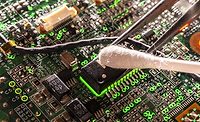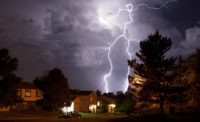The Benefits of Smart Surge Protection

It would be hard to overestimate the importance of electrical devices in today’s world. Every business and every organization relies on electronic devices to provide services, keep records, communicate, and process payments – they literally could not function or stay in business without them. Yet, most of these same businesses are at risk of downtime and equipment damage, either because they are not aware of the threat represented by electrical surge events, or because they do not realize when their surge protection systems are compromised and have stopped providing protection.
If your local convenience store suffers from a power surge that disables or damages their point-of-sale (POS) equipment, lottery terminals, and gas pump controls, it would cause them to lose business and profits. For life safety and security systems, however, it could have even more serious repercussions.
Fire alarms and video surveillance systems are both prime examples of equipment that are not only directly connected to an electrical power supply , but also make use of distributed cabling that can provide alternative paths for damaging power surges. Both of these systems have evolved to make use of sophisticated sensors, notification devices, and communications capabilities that can be located in facility interiors or exteriors.
Because they are connected in order to the supply power, these systems are all at risk of damage caused by power surges – not only from the large, noticeable surges, but also from the many smaller surges that normally pass by unnoticed. Large surges caused by nearby lightning strikes and other dramatic events are an obvious hazard, but even the smaller daily surges have a cumulative damaging effect that can decrease device reliability and shorten equipment lifespan. The distributed network and communications cabling that connect to these systems may cause additional risks, because current can jump to these cables via accidental contact or due to device malfunctions and be carried directly into other sensitive elements of the system. This is a particular concern for any systems with electrical devices or connections that lead outdoors.
To shield these essential systems, surge protection devices (SPDs) should be installed on every potential pathway to ensure they are guarded. Today, a wide range of SPDs are available to match the needs of any installation. Once installed, they protect the connected system from large, externally generated surge events, as well as smaller, daily surge events that are generated by machinery startups, welding, HVAC systems, and many other common internal and nearby external sources.
Still, simply putting surge protection into place is not enough to ensure that your systems will be safe from this kind of damage. In the course of doing their job, SPDs will eventually sacrifice themselves, and no longer provide protection. They may have absorbed a large surge, or many small ones that caused the unit to degrade over time. Either way, once your SPD has ceased functioning, your expensive and sensitive fire alarm or other electronics system is now fully exposed to power surges.
Even worse, not only could a fire alarm or surveillance system now be destroyed by a single nearby lightning strike, the protective function of that life safety system is also jeopardized. If it stops working, the potential for harm or security risk is greatly multiplied – and so is the potential for financial consequences due to fines, the requirement to keep fire responders on-premises until the system is fully restored, or legal liability stemming from a security incident.
Many SPDs have some kind of indicator, usually LEDs, that change from green to red or flash when the SPD has reached the end of its life. Still, this may not solve the problem. How often can management send someone around to every closet and equipment room to check every single surge protector? The moment that person turns away from the SPD, an unnoticed small surge could end the life of the device, leaving the system fully at risk.
The best way to solve this problem is by using a smart SPD with an audible alarm. When the unit stops functioning, it should alert the user – loudly – that it’s time for a replacement. This virtually eliminates the problem of an SPD becoming non-functional without the user realizing it. Ideally, the unit should also alert the user via flashing red LED light for visual confirmation and offer dry contacts for connectivity to alarm panels and direct notification to management.
Surge protection devices are certainly a cost-efficient and effective way to help reduce business downtime, guard against revenue loss, protect lives, and maintain effective security systems, among many other functions. Today’s smart surge protectors not only protect essential electronics systems, but can also call for help when protection has been compromised, closing a huge gap in security and life protection assurance for many organizations.
Looking for a reprint of this article?
From high-res PDFs to custom plaques, order your copy today!






